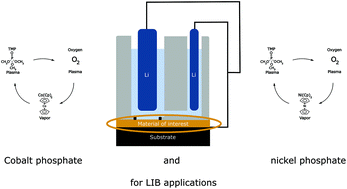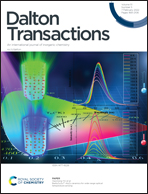Plasma-enhanced atomic layer deposition of nickel and cobalt phosphate for lithium ion batteries†
Abstract
A plasma-enhanced ALD process has been developed to deposit nickel phosphate. The process combines trimethylphosphate (TMP) plasma with oxygen plasma and nickelocene at a substrate temperature of 300 °C. Saturation at a growth per cycle of approximately 0.2 nm per cycle is observed for both the TMP plasma and nickelocene, while a continuous decrease in the growth per cycle is found for the oxygen plasma. From ERD, a stoichiometry of Ni3(P0.8O3.1)2 is measured, but by adding additional oxygen plasma after nickelocene, the composition of Ni3(P0.9O3.7)2 becomes even closer to stoichiometric Ni3(PO4)2. The as-deposited layer resulting from the process without the additional oxygen plasma is amorphous but can be crystallized into Ni2P or crystalline Ni3(PO4)2 by annealing under a hydrogen or helium atmosphere, respectively. The layer deposited with the additional oxygen plasma shows two X-ray diffraction peaks indicating the formation of crystalline Ni3(PO4)2 already during the deposition. The resulting PE-ALD deposited nickel phosphate layers were then electrochemically studied and compared to PE-ALD cobalt and iron phosphate. All phosphates need electrochemical activation at low potential first, after which reversible redox reactions are observed at a potential of approximately 2.5 V vs. Li+/Li. A relatively high capacity and good rate behavior are observed for both nickel and cobalt phosphate, which are thought to originate from either a conversion type reaction or an alloying reaction.

- This article is part of the themed collection: Spotlight Collection: Atomic and Molecular Layer Deposition


 Please wait while we load your content...
Please wait while we load your content...